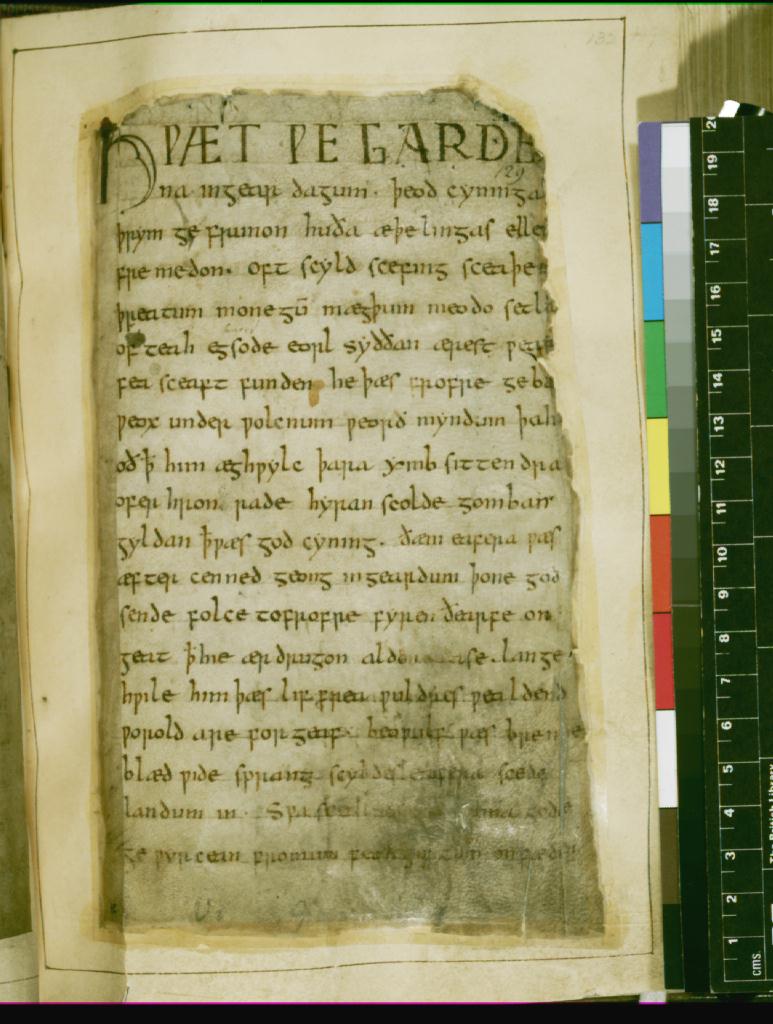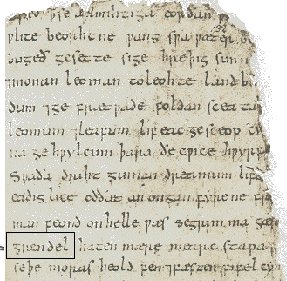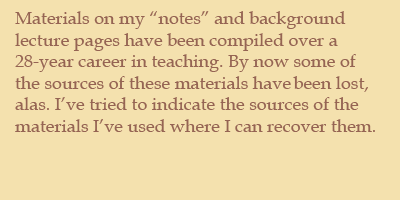Beowulf: first day notes
 Beowulf survives in only one manuscript,
Cotton Vitellius A.xv, which barely survived the fire in Sir Robert Cotton's library in
1731. Had it not been for two pencil transcriptions made by earnest German
graduate students in the early 1800s, many more of the readings of the poem
would have been lost. We are dealing with a chance survival--luck for us the
poem made it. As you can see from the picture, the manuscript is very badly
damaged.
Beowulf survives in only one manuscript,
Cotton Vitellius A.xv, which barely survived the fire in Sir Robert Cotton's library in
1731. Had it not been for two pencil transcriptions made by earnest German
graduate students in the early 1800s, many more of the readings of the poem
would have been lost. We are dealing with a chance survival--luck for us the
poem made it. As you can see from the picture, the manuscript is very badly
damaged.
This is MS. Cotton
Vitellius A. XV, f. 179a.
Beowulf is an
epic: a long heroic poem retelling the exploits of a national hero who faces
down (and overcomes) a threat to the survival of his people. We call it a
folk epic because it appears to combine the works of various authors that
have been woven together over time, and because it lacks the conscious
embellishments of the art epic (epic similes, catalogs, extended metaphors,
etc.) The Beowulf story is a patchwork--or more properly, an example of
interlace (the kind of art you see in illuminated Anglo-Saxon and early
Celtic manuscripts like the Book of Kells), where multiple threads are woven
together to create an overall impact. (See color plates 1, 2, and 3, following
p. 4 in Longman).
In Beowulf, the
threads are the real and imaginary histories of various Scandinavian rulers,
some of whom historically date to the mid-fifth and early-sixth century C.E. The
poem is studded with "set-pieces" of historical allusion--for instance, when
Beowulf is compared to King Heremod in "Hrothgar's Sermon" (pp. 64-66) or when
we are told that Queen Hygd is far better tempered than the famous (if nasty)
Queen Modthryth (p. 69). These were stock pieces for a scop to use--we see that
process at work after Beowulf has killed Grendel, on p. 49, where Hrothgar's
scop compares Beowulf's achievements to the story of Sigemund (and
foreshadows the end of the poem). The set-pieces may be examples of oral
composition--where a known story is worked into a new story.
In literary critical
terms, Beowulf is the hero of the poem--but more technically, he is the
protagonist--that is, the character who drives the action forward. (The
Greek word agon means 'struggle' or 'fight' or 'action.') He has three
antagonists--successively Grendel, Grendel's mother, and finally the dragon
who is his bane or death.
The poem celebrates the
values of a heroic, pre-Christian society: courage, individual bravery and reknown-winning, distribution of treasure, loyalty between overlord and thane,
peace-weaving through the disposition of women in marriage, a stoic acceptance
of fate, etc. Yet it also has Christian themes and values interlaced through
it--Beowulf, for instance, apparently sees no contradiction in saying both "Fate
often favors an unmarked man if he keeps his courage" (line 510) and "May God in
His wisdom grant whom He wills blessing in battle" (614-15). Most scholars see
this as part of the folk-epic nature of the story--the original heroic, Germanic
story has had later Christian values worked into it. This is what happens when a literate Christian scribe writes down a story
composed and elaborated by a group of pre-Christian oral poets; it's worth
thinking about whether the integration of Christianity into the poem is as
smooth here as it is in a poem like The Dream of the Rood.
This is what happens when a literate Christian scribe writes down a story
composed and elaborated by a group of pre-Christian oral poets; it's worth
thinking about whether the integration of Christianity into the poem is as
smooth here as it is in a poem like The Dream of the Rood.
The first half of the
poem is full of sweeping set-pieces of battle and description. Kennings are
everywhere. There is also a lot of irony--for instance, when the poet
says of Grendel, "He hadn't expected to find so strong a handshake", the poet is
using an ironic tone and approach to describe the monster's arm being torn off.
Questions to reflect
on:
Individual and Society:
Why does Beowulf come to Heorot? What is required of a young man in this
culture? Why is he challenged so often? How does the society judge the value of
a person whose individual exploits it doesn't know yet? What role does Unferth
play? What role does boasting play?
Individual and Faith:
How can the poet(s) interlace the belief in fate with the belief in Christian
afterlife? What roles do spells and magic play in the poem? In what kinds of
cultural terms are Grendel and his mother described? What does that say about
the society's overall values?
Women and Men: What
role do Wealtheow and her daughter play? What role(s) did women have in this
society? Why is it important that Beowulf fight Grendel's mother instead
of, say, his brother?

 Beowulf survives in only one manuscript,
Cotton Vitellius A.xv, which barely survived the fire in Sir Robert Cotton's library in
1731. Had it not been for two pencil transcriptions made by earnest German
graduate students in the early 1800s, many more of the readings of the poem
would have been lost. We are dealing with a chance survival--luck for us the
poem made it. As you can see from the picture, the manuscript is very badly
damaged.
Beowulf survives in only one manuscript,
Cotton Vitellius A.xv, which barely survived the fire in Sir Robert Cotton's library in
1731. Had it not been for two pencil transcriptions made by earnest German
graduate students in the early 1800s, many more of the readings of the poem
would have been lost. We are dealing with a chance survival--luck for us the
poem made it. As you can see from the picture, the manuscript is very badly
damaged.  This is what happens when a literate Christian scribe writes down a story
composed and elaborated by a group of pre-Christian oral poets; it's worth
thinking about whether the integration of Christianity into the poem is as
smooth here as it is in a poem like The Dream of the Rood.
This is what happens when a literate Christian scribe writes down a story
composed and elaborated by a group of pre-Christian oral poets; it's worth
thinking about whether the integration of Christianity into the poem is as
smooth here as it is in a poem like The Dream of the Rood.